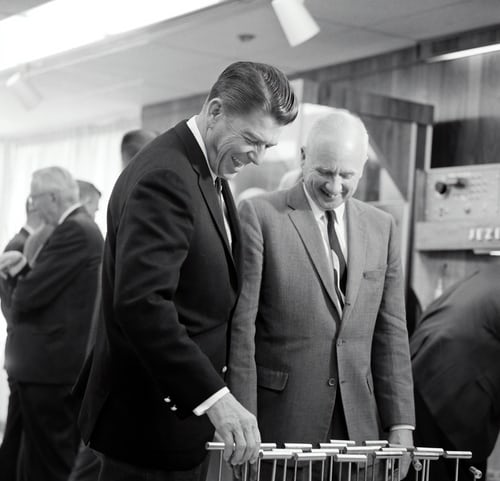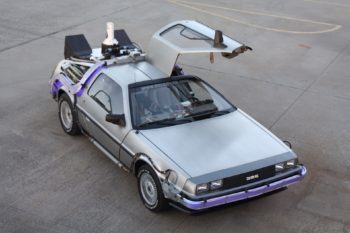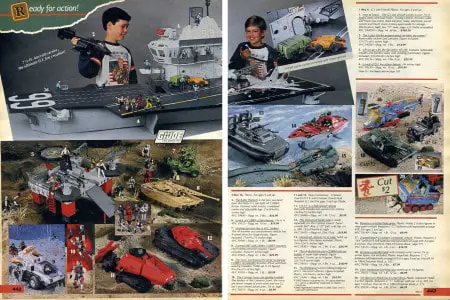
If you grew up in the 80s and loved things like G.I. Joe, and My Little Pony, you have Ronald Reagan to thank.
Ronald Reagan instituted the deregulation of advertising to children in the 1980s. This allowed companies to market as much as they wanted to kids, leading to an explosion of new toys, cartoons, junk food, and breakfast cereals.
Despite the bombardment in advertising we face each day – especially children – there was a time when people were on the lookout for their “promotional well-being.”
Rules had been in place since the 1960s when advertisers discovered how television would be the perfect gateway to get their products in front of as many young eyes as possible. This is important because children dictate so much of a family’s spending.
This article is a look back on deregulation and how it changed the world of advertising to kids forever.
Deregulation and Advertising to Children: Pester Power & Romper Room
Meals, movies, entertainment – they are usually all determined by what the kids want. Children can influence 95% of selecting a restaurant, 89% in what beverages they buy, and 80% of where a family vacation will be taken. They call it “pester power” and it’s a genuine thing.
Remember whining and crying for something you wanted more than life itself, such as a certain toy, cereal, or candy? More often than not, you would end up getting it.
So in the 60s, and with this in mind, advertisers set their sites on the thing that was raising a lot of children more than their parents would – Television. Fortunately, there were watch groups that realized that this was an unfair practice. And what was the first show that they targeted?
Romper Room.
That’s right; the beloved – and seemingly harmless – children’s show (where you hoped you would hear your name in the Magic Mirror) was one of the first targets. Romper Room had, at one point, a line of toys that they would subtly try to promote during the show.
This is nothing new as the advent of television involved product placement within episodes. We get the name ‘Soap Opera’ as television soap operas in the 50s would be produced by soap making companies like Procter & Gamble. The products would be written into the script of the episode to create awareness, and P&G had been doing this as far back as the 1930s, but with radio.
The Attempt to Limit What Could Be Shown on TV
This is all fine and good for daytime television, but it was seen as harmful when it came to targeting children. The Action For Children’s Television (ACT) was formed in 1968 in Massachusetts as a grassroots foundation to improve the quality of children’s programming – and Romper Room would be their first victim.
They also went after any children’s shows that promoted violence such as Fantastic Four, The Herculoids, and Birdman and the Galaxy Trio. The ACT could drive these shows off the air, and this brought us new shows like Scooby-Doo which were seen as less harmful alternatives (but let’s not get into the possible drug influences that existed in it…).
The ACT would spend most of the 1970s gathering information regarding the psychology of advertising to children, and the damage that could come from it. Their findings? Children – especially younger ones – cannot differentiate between a cartoon and a commercial – and advertisers knew this, including toy and junk food manufacturers.
Children have very little understanding that commercials were persuasive, and they could easily buy into the message being sent by the advertiser. The junk food and cereal commercials were the worst as they knew how lucrative ‘pester power’ is.
Putting Regulations in Place
They made every attempt to disguise commercials as cartoons and entertainment, but the ACT would put a crackdown on this. They requested that the FCC put regulations in place that would limit the advertising attack that children were facing. These guidelines included:
- A minimum of 14 hours of programming for children of all ages through the week
- No commercials during children’s shows
- Hosts on children’s shows can not sell (sorry, Miss Jean…)
Shows also needed to disclose when the program was pausing and a commercial was beginning (“This show will be back after these messages…”). Things were going along pretty well.
And then Ronald Reagan became president.
How Did Ronald Reagan Change All This?
One of the first big acts carried out by Reagan, in 1981, was appointed a new head of the Federal Communications Commission: Mark Fowler. And one of the first things Fowler did was deregulated everything that had been in place up to that point. He claimed that the marketplace should dictate what was to be successful and nothing should stand in the way of that.
Children be damned!
The ACT didn’t want to take this lying down, started a task force, and compiled 60,000 pages of expert testimony from child psychologists and nutritionists. The research reiterated the fact that young children cannot distinguish between an ad and reality.
The ACT also was looking out for the best interests of kids and campaigned for higher-quality shows that had an educational component and were not just marketing tools.
They raised 16 million dollars to lobby against this task force and you obviously know who won out. Fowler nixed this task force, of course, and 1981 would be doomsday for many classic educational, and beloved, shows.
First on the chopping block was Captain Kangaroo followed by Schoolhouse Rock, the very fitting Kids Are People Too!, and Animals, Animals, Animals.
And then the floodgates opened…
The Changing Landscape of 1980s Entertainment
With deregulation lifted, and no restrictions holding them back, manufacturers could now do whatever the hell they wanted. This is why you see an explosion of toys, cartoons, candy, fast food items, and junk food in the 1980s.
Cartoon-wise, we would get shows like G.I. Joe, Transformers, He-Man, My Little Pony, Rainbow Brite, Care Bears, Voltron (enter your favorite 80s cartoon here). There was a 300% increase in cartoons that had licensed characters, and as much as we loved these shows, let’s be realistic: They were nothing more than 22-minute commercials to sell toys and products.
(check out my blog on the best toys of the 80s here)
G.I. Joe and Transformers are notable standouts in taking advantage of deregulation: They started with a short miniseries to launch the characters and backstory of their respective worlds. This would get kids up to speed with the main characters and vehicles they would soon scream for in stores.
The toy manufacturers themselves were now intensely involved with the production of the new cartoons – and children’s programming in general – and shows based on any toy you could think of were put into production (remember Rubik, The Amazing Cube?).
Not only that, but the broadcasters were also enticed to schedule these shows in exchange for a part of the profit from the toy sales. It was basically the Wild West of advertising now.
How G.I. Joe Perfected Advertising To Children
G.I. Joe is worth looking at as a masterclass in how to market to children. Over the course of the series, they would release over 250 different vehicles and hundreds of action figures. Each episode of G.I. Joe would usually be focused on a specific new character and/or vehicle that would shortly be released.
You would then see these same action figures, vehicles, and accessories advertised when G.I. Joe would go to commercials. This is also why when you watch old cartoons like this you may notice they always refer to each other by their full name and refer to the vehicle by its specific description. It wouldn’t be “Hey man, jump in the helicopter”, it would be “hey Duke, jump in the Dragonfly Helicopter.”
Kids needed to know the exact name of the product they would now die to have. This makes it a lot easier when searching for it in a store or writing out wish lists for Christmas and birthdays (with Christmas – unsurprisingly being when episodes were chocked full of new vehicles and characters).
It’s worth pointing out that many of these cartoons had some great creativity to them early on. The Transformers universe was developed by Marvel Comics, and some real thought and story design went into creating this new world. But like all the other cartoons, Transformers would just become a parade of products.
The Transformers movie from 1986 is another excellent example of specifically marketing toys. A large gap existed between the second and third seasons to put out Transformers: The Movie. If you grew up during this time, and were a Transformers fan, you know how traumatizing this movie was.
It featured the death of several principal characters, including the iconic Optimus Prime. This was all done intending to clear away all the discontinued products from 1984 to 1985 and introduce a new cast of characters for the 1986 toy release.
Kids were so pissed about the death of Optimus Prime that a massive letter-writing campaign was undertaken that forced Hasbro to ‘resurrect’ him in a two-part episode in 1987.
Junk Food Gets in on the Action
Cereal and junk food manufacturers would now have free rein to disguise commercials as cartoons as it was understood that children identify more with cartoons than with reality. Add to this the inclusion of any animals to build even more trust with kids.
Anthropomorphism is using animals to sell products – and it works. It’s why you would see pretty much every cereal company use some sort of animal/cartoon mascots such as Tony The Tiger, the Honey Nut Cheerios Bee, Toucan Sam, the Trix Rabbit, and Dig’em the Honey Smacks frog just to name a few.
This is also one of the reasons you would see Joe Camel used to make cigarettes more appealing to kids. Basically, in the 80s, selling things and cartoons became one and the same.
Check out my article all about the best cereal of the 80s here!
How Was This All Able to Happen??
Where was the ACT during all this? They pretty much had their hands tied but were still begging that educational shows be produced for commercial stations. Mark Fowler adamantly would state that these stations were within their first amendment rights to air any shows they wished.
By 1988, congress was looking deeper into the bombardment of junk food and advertising in general. They at least wanted to restrict the direct targeting of children and come up with some guidelines.
The idea was to limit advertising to 10.5 minutes on weekends and 12 minutes on weekdays. Cartoons would also have to provide some educational info (“…and knowing is half the battle…”) and this would all be put to a vote.
This new bill to protect the kids passed 328-78 in the House, and unanimously in the senate. And then Reagan vetoed it as one of his last acts as president in November 1988.
Screw you, kids…
Cooler Heads Finally Prevail
Things would come around in 1990 as the new Children’s Television Act (CTA) was put in place. The CTA was an act of Congress that ordered the FCC to put in place regulations to protect children from advertising. They also demanded that educational and more informative shows be put out for the betterment of kids.
The commercial time during kids’ shows was now limited to 12 minutes per half-hour on weekdays and 10.5 minutes on the weekends. They also banned advertisements for toys that were being aired during the shows that the toy was based on aka; the exact foundation of G.I. Joe.
Hosts were not allowed to sell and a clear separation had to exist between program and commercial during children’s shows, so they knew commercials were coming.
You may remember all those catchy commercial-bumpers or break-bumper jingles – 2 to 15 seconds in length – from Saturday morning cartoons and that’s why those existed.
These regulations would be effective, but, to no one’s surprise, broadcasters would find ways around these regulations. Instead of having to pay to create educational content, some broadcasters would air reruns of shows like Leave It To Beaver, The Flintstones, and the Jetsons claiming they would cover moral and social issues and were therefore “educational.”
In a real slap in the face to the old ACT, some broadcasters would air G.I. Joe episodes because of this same workaround.
Final Thoughts on Deregulation & Advertising to Children
So that’s the crazy story of deregulation. The 1980s were not just a time of crimped hair, spandex, and leg warmers—but a time when some huge pop culture shifts happened.
We look back on a lot of the entertainment from the decade with nostalgia, but all of it was completely commerce-driven. I supposed we were better off than not having it at all, but we have a former actor from Tampico, Illinois to thank.




Comments
Comments are closed.